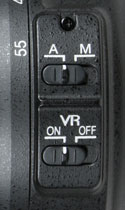Nikkor AF-S DX 18-55mm f/3.5-5.6 G VR
-
-
Written by Gordon Laing
Nikkor DX 18-55mm VR design and build quality
The Nikkor DX 18-55mm VR and its predecessor the DX 18-55mm II are pictured below at their shortest configurations. It’s clear to see when pictured side-by-side that while they’re similarly styled, the new version is chunkier. The DX 18-55mm VR measures 73mm in diameter and 80mm in length compared to the 71x74mm of its predecessor. The VR version is also heavier at 265g compared to 205g for the Mark II. That said, it’s not a significant difference in size or weight in practice, with the new VR version still feeling like a compact and light lens.
The build quality is roughly the same, although the zoom ring on our VR sample felt a little stiffer in operation – this could be due to the relative ages of the samples tested though. Like its predecessor it has plastic construction with a plastic lens mount. Consequently as a budget kit lens, the build quality is unsurprisingly no match for pricier models, but is decent for the money. It feels fairly solid and well-built without any creaks or play in the moving parts.
Interestingly Nikon has also opted for a slightly mottled textured finish on the new VR version which gives it a classier, less plasticky appearance than its predecessor which could look quite shiny at times.
Like its predecessor, the internal barrel extends when zoomed out, before retracting to its shortest position at around the mid-way mark, then extending again when zoomed-into 55mm – see photo. There’s a 52mm filter thread at the end, but again like the Mark II lens, this section rotates when focusing which will annoy users of polarising or graduated filters. This rotating front section also eliminates the possibility of using a petal-styled lens hood, and instead the DX 18-55mm VR must employ the less effective short HB-45 lens hood – it’s an optional accessory, but of limited use at anything other than wide angle.
As an AF-S model, the DX 18-55mm VR employs an SWM focusing motor. This allows it to autofocus quicker and more quietly than most budget kit lenses, and also means it’ll work with the D40, D40x and D60 bodies which don’t have focusing motors of their own to drive non AF-S lenses. Not all SWM motors are created equal though and the speed and noise are not in the same league as premium Nikkor lenses – indeed our sample squeaked slightly in operation – see video tour – but again it was still a big improvement over most rival kit lenses.
 |
Manual focusing is possible, but you’ll first need to disengage the AF system by switching the lens from A to M on the side of the barrel; sadly there’s no full-time manual focusing here and if you attempt to manually focus while the motor is engaged, you risk damaging the system. Once disengaged though, you can manually turn the end section of the barrel to manually focus.
Like its predecessor, there’s no actual manual focusing ring, but as you can see from our first photo at the top of the page, the ‘grip’ on the end of the barrel is at least a little deeper. That said, there’s not a lot to hold onto when the barrel is at its shortest length and fine increments can be tricky. Manual focusing is certainly possible, but if it’s important to you, a higher-end lens would make more sense.
In terms of optical design, the new DX 18-55mm VR may share the same focal length and f3.5-5.6 focal ratio as its predecessor, but internally it’s quite different: it employs 11 elements in 8 groups compared to the 7 elements in 5 groups of the Mark II. Interestingly the new VR version is also missing the ED element of its predecessor.
This greater optical complexity may have eliminated the need for an ED element and of course is partly necessary to accommodate the VR facilities, but has it had any impact on overall image quality? If you can’t wait, then check out our results pages to find out, or head to our Features page to see the coverage and stabilisation in action.



